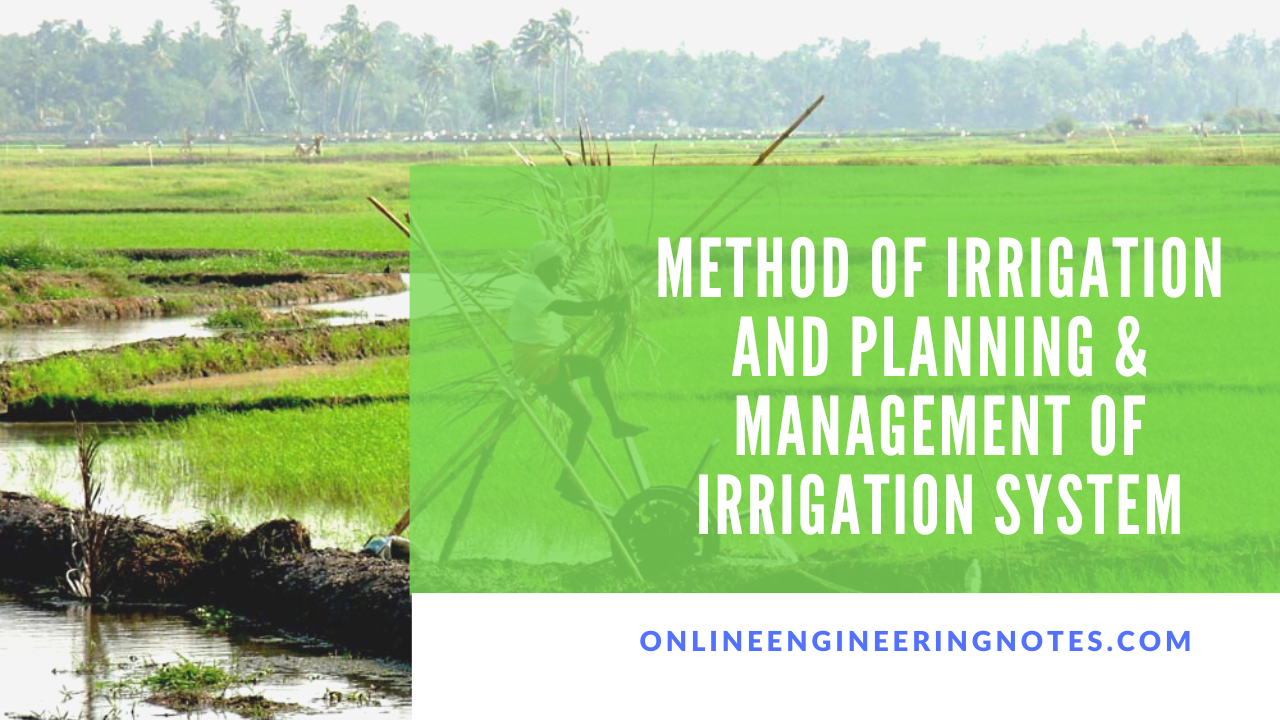1.1 Different method of irrigation:
1. Free flooding:
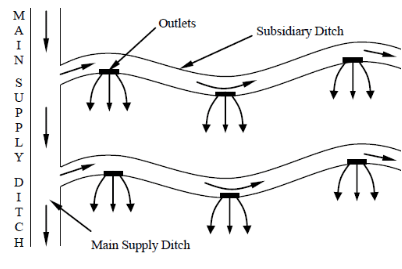
- Ditches are excavated on field and water is allowed to flow across the field with no control mechanics.
- Suitable for irregular land.
- Inefficient method of irrigation.
2. Border flooding:
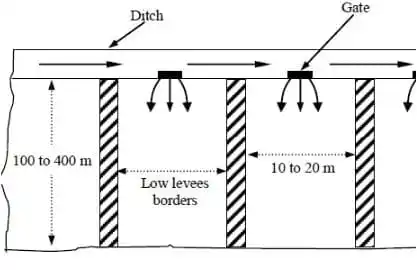
- Land is divided into a number of strips with the help of low levees.
- Each strip has 10 to 20 meter width and 100 to 400 meter length.
- Supply of water is stopped once it reduce lower end.
- Suitable for close crops.
3. Check flooding:
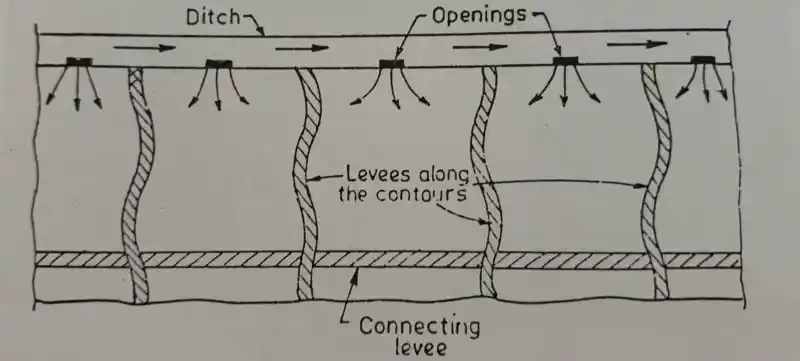
- Similar to ordinary flooding except water is controlled with help of low and flat levees.
- Reduce percolation loss.
4. Basin Flooding:
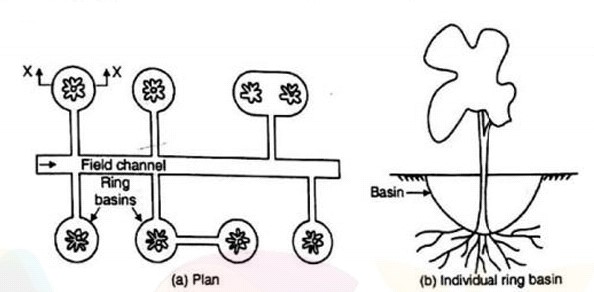
- Special type of check flooding which is adopted specially for orchard tree.
- One or more tree are placed in basin and surface is flooded.
5. Furrow irrigation:

- Narrow ditches excavated between rows of plants and carry water through them.
- Spacing of furrow depends upon spacing of plants.
6. Sprinkler irrigation:
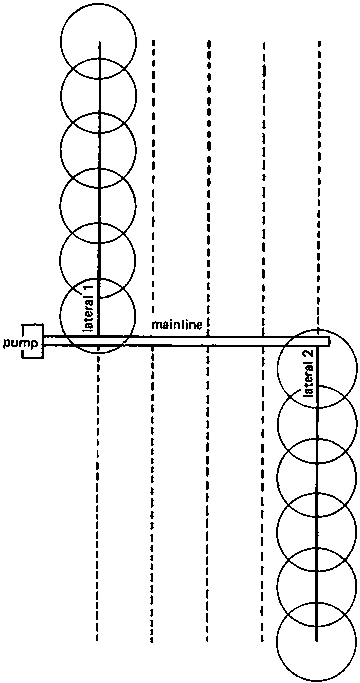
- Water is applied to soil in the form of spray through network of pipes and pumps.
- Suitable:
- Topography is irregular.
- Land gradient is steeper.
- Crop water requirement is low.
- Classified as:
- Permanent system
- Semi- permanent system
- Portable system
- Advantage:
- Seepage losses is completely eliminated.
- Land levelling is not required.
- No extra land required for ditches.
- High efficiency.
- Disadvantage:
- Affected by high wind.
- Not suitable for crops with high water requirement.
- Not suitable for high temperature area.
1.2 Hydraulics of irrigation distribution:
1. Advance phase:
- Time interval between the start of irrigation and arrival of the advancing (wetting) front at the lower end of the field.
2. Ponding phase:
- Irrigation time extending between the end of advance and inflow cut-off.
3. Depletion phase:
- Time interval between supply cutoff and the time that water dries up at the inlet boundary.
4. Recession phase:
- Time required for the water to recede from all points in the channel starting from the end of the depletion phase.
1.3 Efficiency irrigation method:
1. Efficiency of water conveyance:
- Ratio of water delivered into the field from the outlet point to the water entering into the channel at its starting point.
2. Efficiency of water application:
- Ratio of quantity of water stored into the roof zone of the crops to the quantity of water actually delivered into the field.
3. Efficiency of water storage:
- Ratio of quantity of water stored into the root zone during irrigation to the water needed in the root zone.
4. Efficiency of water use:
- Ratio of water beneficially used including leaching water to the quantity of water delivered.
5. Uniformity coefficient or water distribution efficiency:
- Represents the extent to which water has penetrated to a uniform depth throughout the field.
η = (1 – d/D)
where,
d = Average absolute value
D = Mean depth
1.4 Operation and management needs of surface and ground water irrigation schemes:
Operation of irrigation system:
- Operation of irrigation system is a package of organisational, economical and technical arrangement that ensure planned distribution and full use of water resource for heavy yield of agricultural crops of good quality under irrigation conditions.
- Operation measure includes:
- Implementation of schedule water use practice to provide the irrigation regime required under specific meteorological condition on certain land areas under efficient water use.
- Keeping irrigation, drain and other canal in working state by proper supervision and maintenance.
- Prevention of excess water.
- Control water loss of canal.
- Organization of irrigation water accounting.
1.5 Canal operation plan:
- Method of organizing water delivery in a planned way by releasing, conveying and dividing water in canal system.
- It includes:
- Starting and closure of season.
- Starting storage.
- Irrigation release schedule.
- Responding to specific situation.
Data required for operation plan:
1. Water resource:
- Availability
- Storage status
- Inflow
2. Water demand:
- Cropping plan
- Rainfall
3. Canal status:
- Discharge
- Water level
- Losses
4. Irrigation schedule:
- Timing
- Duration
1.6 Participatory management:
- Participatory management is the participation of irrigation users in the management of irrigation system.
- Recognised all over world as tool of improving irrigation management along with sustainability of the system.
Objective participatory management:
- To promote and secure distribution of water among user and economic utilisation of water in agriculture.
- To protect environment and to ensure ecological balance inculcating sense of ownership of irrigation system.
- Users are directly involve in design process which will ensure better understanding of design and management of system.
- Farmers will have better idea of accounting, budgeting, planning and organizing techniques.
- Farmers can manage and operate the system more cheaply than government agencies.
References:
- WECS (1998), Design Guidelines for Surface Irrigation in Terai and Hills of Nepal, (Vol. I and II)
- Michael, A.M.(2011). Irrigation theory and practice
- FAO(1977). Guidelines for Predicting Crop Water Requirements. FAO Irrigation and Drainage Paper No. 24.

